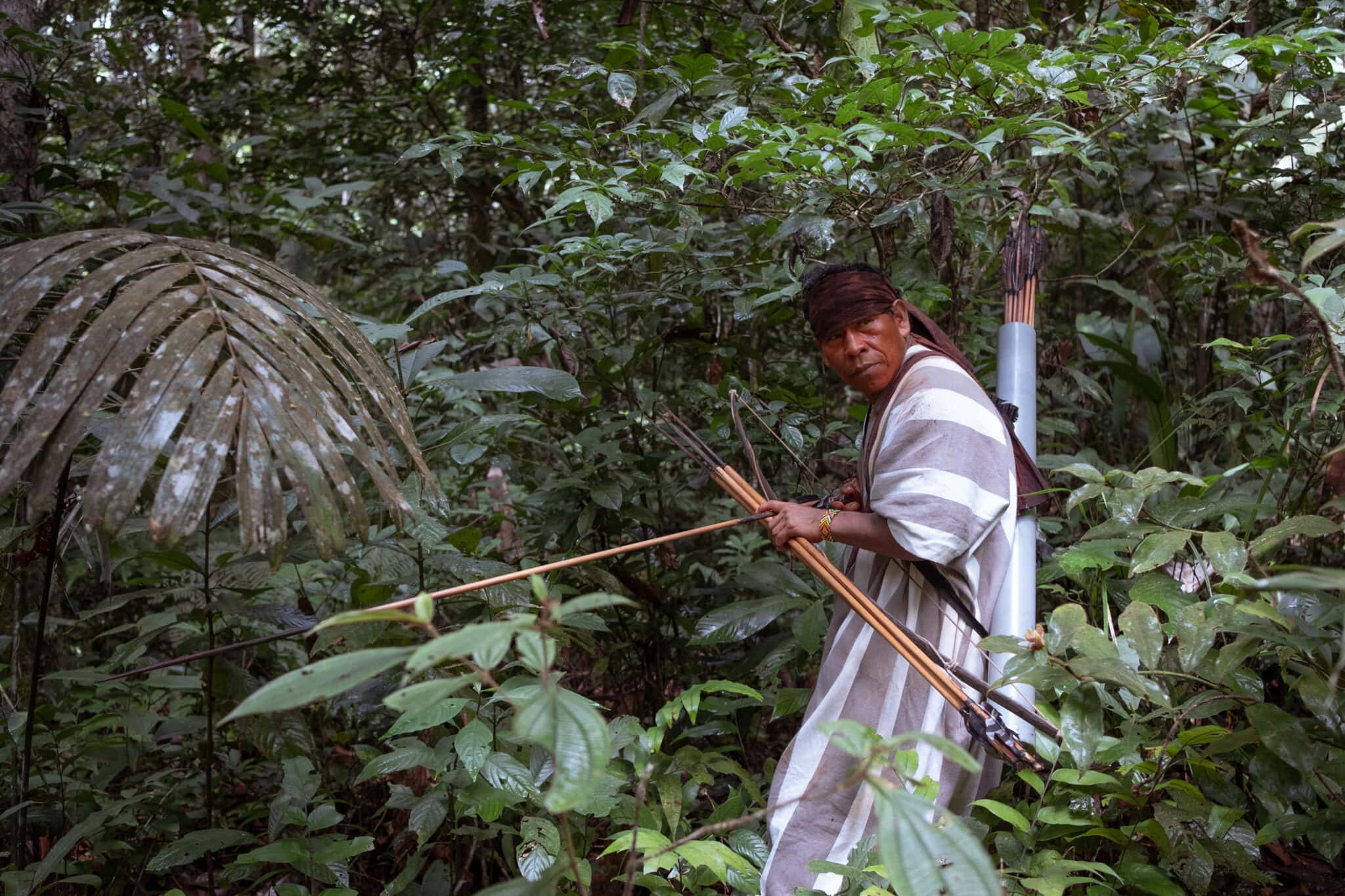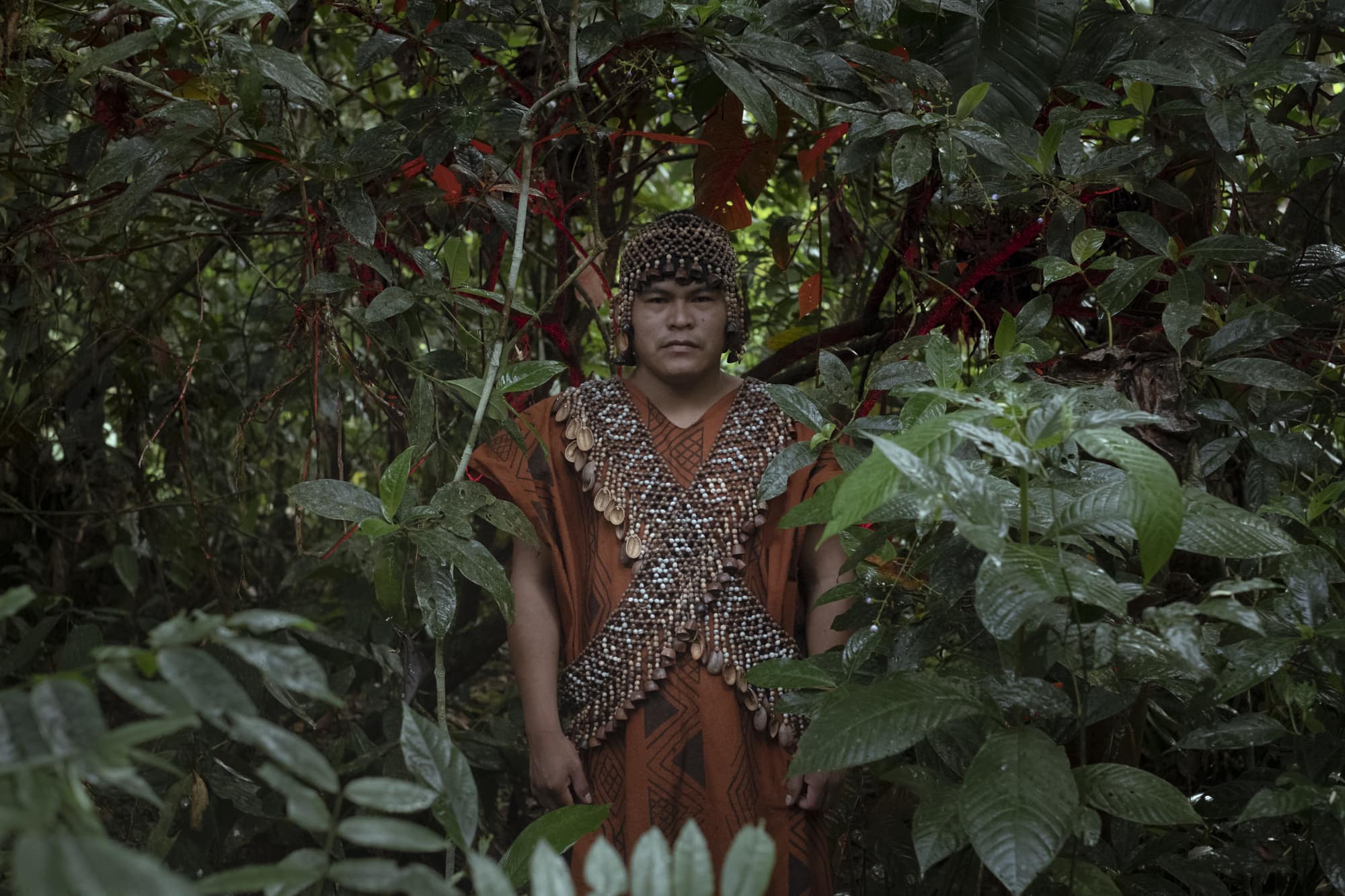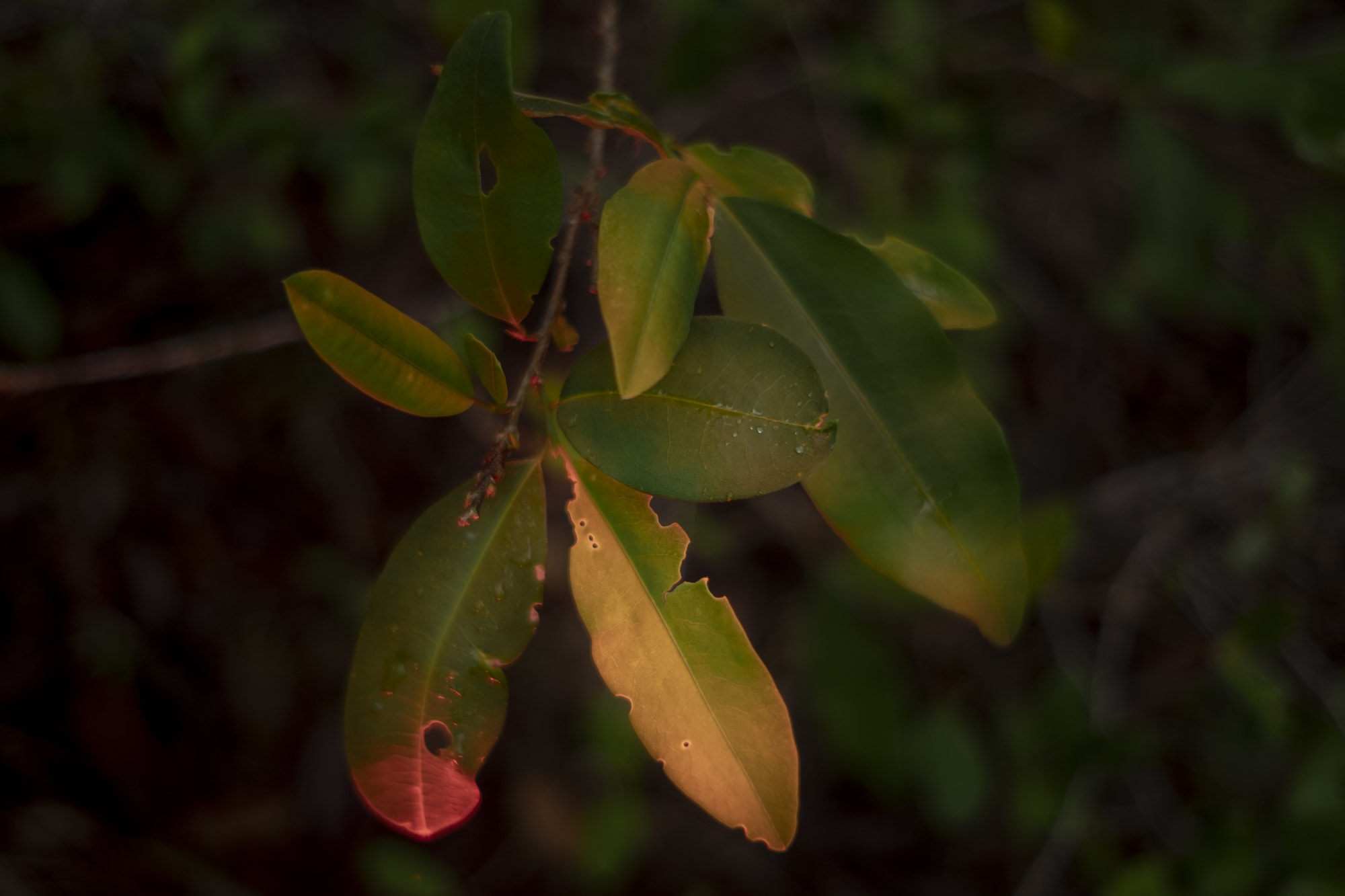
The Kakataibo’s Battle
Twenty indigenous leaders have been killed in the Peruvian Amazon since the beginning of the pandemic. Without state authorities, the region’s communities face the threat of drug trafficking and illegal loggers alone. But they have decided to defend themselves: the Kakataibo ethnic group has reached a historic agreement with the indigenous organization ORAU to maintain their communities’ security jointly. Florence Goupil, Peruvian-French photographer, and National Geographic explorer, was there to document it.
By Alonso Almenara
In the work of documentary photographers, there are moments when the unthinkable can happen: a bomb threat, an attack, an assassination on camera. That was very much on Florence Goupil’s mind as she covered for Le Monde newspaper a historic meeting between Kakataibo, Asháninka, and Shipibo leaders, which took place in June 2021, in the village of Yamino, Ucayali, a central jungle of Peru.
Drug traffickers besiege the area. They arrive armed with machine guns and invade the lands of the Kakataibo community to grow coca leaves. A plant traditionally consumed in Peru but is also used to produce cocaine. The drug traffickers transform it in clandestine laboratories before sending it in paste or powder form by plane to Brazil or Bolivia.
Since the beginning of the pandemic, the Peruvian government has drastically reduced its presence in the Amazon. First, the health services crisis broke out. Now the main threat in the region is the explosive increase in drug trafficking and illegal loggers. The United Nations Office on Drugs and Crime estimates that nearly 50,000 hectares of forest have been destroyed by drug trafficking in Peru, including thousands in Ucayali. Cases of kidnappings, murders, and torture have multiplied: the police have recorded 171 threats and 20 leaders murdered since January 2020. Among them three Kakataibo.
The village of Yamino has about fifty families. They live from hunting and fishing to cultivating bananas, papaya, cassava, and cocoa. Today, the security of this Kakataibo community is so compromised that they are forced to take up arms to defend themselves. In May 2021, Herlin Odicio, a young Kakataibo leader, contacted the Aidesep Ucayali Regional Organization (ORAU), led by Berlin Diques, to establish an unprecedented defensive alliance in the Peruvian Amazon.
Florence Goupil was present at the meeting. She has a long-standing interest in Amazonian communities, which she has documented for publications such as National Geographic and Ojo Público. “My dad is French, that’s why my name is Florence, but my mom’s family’s last name is Quispe,” Florence says. “She’s from Cusco and Huancavelica. I’ve grown up listening to their stories and those of my grandparents: I’ve always loved those myths, the use of plants, and their relationship with biodiversity.”
At age twenty, she met a Shipibo couple who practically adopted her. Since then, she has traveled to the jungle every year. “At the beginning, I had no interest in taking photos. I was very young. But it was during one of those trips Gabriel, my Shipibo father, asked me to use the camera. He told me: ‘I want you to listen well to the stories I’m going to tell you and represent them in photography as you can.’ At that moment, I realized that it was possible to take pictures of magical stories, myths, or their sensitive relationship with their territory.
In recent years, Goupil has traveled the Amazon to record peoples’ struggles, such as the Kakataibo, the Aguajún, and the Bora. In the photographic series Kakataibo, las voces del bosque, she documents the beginning of something new: the articulation of a significant indigenous movement to confront organized crime in a region abandoned by the State.
“Today, there is no space in the Peruvian press that seriously reports on the problems of the Amazonian communities. When they are mentioned, they are associated with terrorism, the Shining Path, and the Vraem. The press does not get out of it. And we saw it clearly during the protests against the government of Dina Boluarte a few months ago: the newspapers terrorized the demonstrators.”
How did the project Kakataibo, the Voices of the Forest, come about?
I have been working with indigenous communities for a long time. During the pandemic, I became very involved with the Shipibo-Konibo people, who were struggling to protect the elders of their communities, as well as their leaders and their culture. I worked a lot in the Ucayali. And one day, I was contacted by the journalist Amanda Chaparro from Le Monde: she had heard that Herlin Odicio, one of the most influential leaders of the Kakataibo ethnic group, was going to meet Berlin Diques, the president of the indigenous organization ORAU. It was a historic meeting because indigenous organizations in Peru are not usually very articulated among themselves. Chaparro told me they would meet in Yamino, a Kakataibo village that is very close to an area invaded by drug traffickers and illegal loggers. Odicio called this meeting in May 2021, shortly after the assassination of two Kakataibo leaders: Herasmo García Grau, from the Sinchi Roca community, and Yenes Ríos Bonsano, from the Puerto Nuevo community. Le Monde called me because I was already in contact with the Kakataibo and knew the area.
Despite your experience working in Ucayali, doing this report with people in constant danger must have been complicated.
Yes, it was tough. I spent three days waiting for Herlin who told me he was coming and he didn’t come, because he is a man who is always hiding. He can never give his position. Besides, I didn’t know what to expect or what kind of images would appear before my eyes. I sometimes thought the story would not happen because the leaders didn’t always respond to my messages or stand me up. It was frustrating. It seemed impossible.
Things finally came together when Berlin Diques, the head of the ORAU, arrived in Yamino. He arrived to say: ‘We support you, the Ashaninka are with you, with the Kakataibos, and we are going to use arms to defend our lives and our territories.’ It was something that impressed me very much to see two indigenous ethnic groups united, ready to defend themselves together. There is beauty that emerges in those moments.
The photo in which they are all together is particular because sometimes you can say to someone: “Do you stand like this to take a portrait? But in this case, it wasn’t like that. On the contrary, they positioned themselves in this half-mountainous forest and told me you can take the picture now.

What is the Peruvian State’s response to the threats and murders in this region?
The indigenous communities are entirely abandoned. I think the most blatant was during the pandemic: there were no functioning health posts and no access to medicines. These people didn’t even have critical information to protect themselves.
The invasions of indigenous territories are already too numerous. They often live under threat. A few weeks ago, Santiago Contiricon Antunez, a historically significant Asháninka leader, was killed. He was 58 years old. That shows that none of them are protected.
One of the things that Herlin, who is threatened all the time, told me is that the only thing the authorities have given him is a police report. Tomorrow he will be shot, and that paper is useless. Santiago Contiricon Antunez participated, like many Asháninkas, in the fight against terrorism. He was an essential character in our history, and it is horrible that the Peruvian government has never given him protection.
Today there is not even an analysis of why, since the pandemic began, the murders and threats against indigenous leaders have skyrocketed. What is happening in Peru right now so that illegal loggers and drug traffickers can freely enter these territories without any control from the State?
What do you think is happening?
If there are extractive companies in these territories, they promise things the government will never offer. For example, these people need a reasonable sum of money for their children to study or to have something as basic as access to a hospital. In such an impoverished and unequal country, what alternatives do they have?
Almost all your photos are published in foreign magazines. Do you think there is no interest in this kind of story in Peru?
I’ll be honest with you: the Peruvian press is racist. I am referring to the people in positions of power, not necessarily the photographers. However, we could also talk about how Peruvians photograph other Peruvians.
During the pandemic, I covered the situation of a Shipiba community in Cantagallo. One day one of these covid-19 people died. The district specifically asked a Lima newspaper not to publish photos of their dead. Evidently, this newspaper would not post pictures of the corpse of a well-to-do family member from the capital. But they still took the photo of the deceased, and it ended up on the back page of the newspaper. The body was on a table, wrapped in a blanket. You could see his face. It was very hard for the community.
Nowadays, no space in the Peruvian press seriously reports on the problems of the Amazonian communities. When they are mentioned, they are associated with terrorism, the Shining Path, and the Vraem. The press does not get out of it. And we saw it clearly during the protests against the government of Dina Boluarte a few months ago: the newspapers terrorized the demonstrators.

You mentioned the subject of how Peruvians photograph other Peruvians. What did you want to say about that?
Peruvians have very little memory of our origins and our context. If we want to know what the situation of Peruvians was before the 1970s, for example, there are very few museums or places of memory that can give us a clear idea. In photography, the same thing happens: we know little of the work of a figure like Martin Chambi, whose production has never been analyzed politically. These shortcomings lead us to imitate the gaze of foreign photographers who have come to photograph indigenous communities. I have been thinking about it for many years because I did not want to fall into that kind of look. It is a constant struggle for all photographers who wish to create new things not to fall into exoticism.
We know that in Peru, there are murders of indigenous leaders every year. And yet there seems to be no interest from the media, the State, or a large part of society to remedy this situation. How did we get to this point?
After the internal armed conflict, I think the State made the mistake of not recognizing the struggles of the indigenous communities in the Amazon. It was never clearly established who were the terrorists and who were the victims. So most Peruvians do not know that the Ashaninka fought against terrorism. The government prefers to maintain the version that we owe the achievements in the anti-subversive struggle exclusively to the police and the military instead of recognizing, in the first place, that the indigenous people also played an important role and, secondly, that they were affected and killed by attacks from both sides.
The contribution of a leader like Santiago Contiricon Antunez was never acknowledged by society. It was never said publicly: he fought against terrorism and is a national hero. They didn’t, and they never will. And that is one of the reasons why Peruvians continue to see the indigenous people of the Andes and the Amazon as if they were backward, violent, resentful, and terrorists.
E·CO/23]
This work is one of the inspirations for E-CO/23], the new edition of our meeting of photographic collectives, which this year will have as its thematic axes: Ecologies, Territories, and Communities.
Through this call, we are interested in gathering stories of sustainable development, community movements, and ways of inhabiting the land in the community to achieve new narratives built from the plurality of collective creation.
Each selected project will receive support of 5,000 euros for its production. The tasks can be presented by existing collectives or by groups of people working in collaboration for this project in an interdisciplinary way.
The selected groups will participate in a collective process of production and reflection that will be accompanied by pedagogical support with specialists in the themes.
Once the production stage is completed, the project results will be presented in one or more exhibitions that may rotate and on the digital platforms of Fundación VIST, the AECID, and the participating Spanish Cultural Centers or the institutions they designate. The aim is to consolidate networks for creating and circulating visual narratives in Ibero-America.


